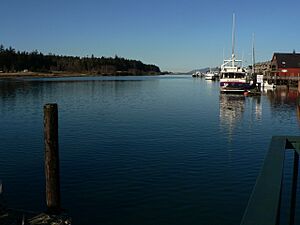Swinomish Channel facts for kids

The Swinomish Channel is a salt-water waterway in Washington state, United States. It is about 11 miles (18 kilometers) long. This channel connects Skagit Bay in the south to Padilla Bay in the north. It also separates Fidalgo Island from the mainland part of Skagit County.
The Swinomish Channel is one of three main entrances to Puget Sound. The other two are Deception Pass and Admiralty Inlet.
Contents
What is the Swinomish Channel?
The Swinomish Channel is a mix of natural and man-made parts. Before it was dug deeper, it was a group of shallow tidal areas. These areas included muddy spots and marshlands. People called this area the Swinomish Slough.
How the Channel Was Made
The United States Army Corps of Engineers helped create the channel. They used special machines to dig out the mud, a process called dredging. They also built walls, known as dikes. This work made the channel deep enough for boats to travel through. The project was finished in 1937, during a time called the Great Depression.
Who Uses the Swinomish Channel?
Many different types of boats use the Swinomish Channel.
- Fishing boats: These boats travel through the channel to reach fishing areas.
- Tugs: Tugboats pull larger ships or barges.
- Recreational boats: People use these boats for fun, like sailing or cruising.
- Freight vessels: These are smaller cargo ships that carry goods.
Keeping the Channel Open
To make sure boats can always use the Swinomish Channel, it needs to be dredged often. This means digging out the mud and sand that builds up. The channel should be dredged at least every three years.
Recent Dredging Efforts
In the 1990s, the special money set aside for dredging was stopped. A study done between 2004 and 2008 showed a problem. It found that if the channel wasn't dredged, its northern part would be too shallow for almost all boats by 2015. The southern part would become too shallow by 2019.
The channel was dredged again in 2008. In 2012, the Army Corps of Engineers received money from the government. This money was for another dredging project. That project was completed in January 2013. The channel was most recently dredged in 2018.

